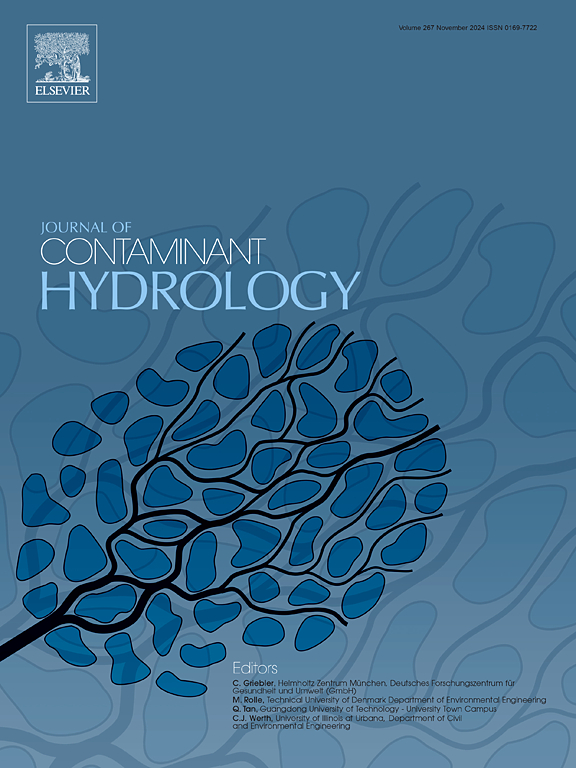The effect of sub-boiling temperatures on mass transfer from former manufactured gas plant residuals
IF 3.5
3区 环境科学与生态学
Q2 ENVIRONMENTAL SCIENCES
引用次数: 0
Abstract
The dissolution of polycyclic aromatic hydrocarbons (PAHs) from coal tar at former manufactured gas plant (FMGP) sites is a long-term threat to groundwater quality. The dissolution rate is often limited by an increase in the viscosity of the non-aqueous phase liquid (NAPL) as the lower molecular weight compounds are depleted over time, and this slow mass transfer prevents the effective application of remediation technologies that rely on NAPL-to-water mass transfer to remove or degrade mass. Increasing subsurface temperatures has the potential to increase mass transfer at FMGP sites by increasing PAH solubility and reducing NAPL viscosity. This study investigated the mass transfer of PAH compounds from a synthetic NAPL mixture and FMGP residual at 25, 50 and 80 °C using well-mixed batch experiments. Effective solubilities increased by up to an order of magnitude and mass transfer rate coefficients increased by up to a factor of 45. Enhancements were greater for higher molecular weight compounds, and for the more complex FMGP NAPL compared to the synthetic mixture due to a more substantial decrease in NAPL viscosity. Simulations using a screening-level model demonstrated the potential for sub-boiling temperature to increase NAPL mass removal at FMGP sites, with increases in concentration up to a factor of seven, and 6 to 87 % of mass remaining after heating to 80 °C for 120 days compared to 25 °C.
亚沸点温度对原制气厂渣油传质的影响。
煤焦油中多环芳烃(PAHs)在原煤气厂(FMGP)场地的溶解是对地下水质量的长期威胁。溶解速率通常受到非水相液体(NAPL)粘度增加的限制,因为低分子量化合物会随着时间的推移而耗尽,这种缓慢的质量传递阻碍了依赖于NAPL-水质量传递来去除或降解质量的修复技术的有效应用。增加地下温度有可能通过增加多环芳烃的溶解度和降低NAPL的粘度来增加FMGP位点的传质。本研究通过充分混合的批量实验研究了合成NAPL混合物和FMGP残留物在25、50和80°C下的传质。有效溶解度增加了一个数量级,传质速率系数增加了45倍。与合成混合物相比,高分子量化合物和更复杂的FMGP NAPL的增强效果更大,因为NAPL的粘度降低得更明显。使用筛选水平模型的模拟表明,亚沸点温度有可能增加FMGP站点的NAPL质量去除,浓度增加高达7倍,与25°C相比,加热到80°C 120天后仍有6%至87%的质量残留。
本文章由计算机程序翻译,如有差异,请以英文原文为准。
求助全文
约1分钟内获得全文
求助全文
来源期刊

Journal of contaminant hydrology
环境科学-地球科学综合
CiteScore
6.80
自引率
2.80%
发文量
129
审稿时长
68 days
期刊介绍:
The Journal of Contaminant Hydrology is an international journal publishing scientific articles pertaining to the contamination of subsurface water resources. Emphasis is placed on investigations of the physical, chemical, and biological processes influencing the behavior and fate of organic and inorganic contaminants in the unsaturated (vadose) and saturated (groundwater) zones, as well as at groundwater-surface water interfaces. The ecological impacts of contaminants transported both from and to aquifers are of interest. Articles on contamination of surface water only, without a link to groundwater, are out of the scope. Broad latitude is allowed in identifying contaminants of interest, and include legacy and emerging pollutants, nutrients, nanoparticles, pathogenic microorganisms (e.g., bacteria, viruses, protozoa), microplastics, and various constituents associated with energy production (e.g., methane, carbon dioxide, hydrogen sulfide).
The journal''s scope embraces a wide range of topics including: experimental investigations of contaminant sorption, diffusion, transformation, volatilization and transport in the surface and subsurface; characterization of soil and aquifer properties only as they influence contaminant behavior; development and testing of mathematical models of contaminant behaviour; innovative techniques for restoration of contaminated sites; development of new tools or techniques for monitoring the extent of soil and groundwater contamination; transformation of contaminants in the hyporheic zone; effects of contaminants traversing the hyporheic zone on surface water and groundwater ecosystems; subsurface carbon sequestration and/or turnover; and migration of fluids associated with energy production into groundwater.
 求助内容:
求助内容: 应助结果提醒方式:
应助结果提醒方式:


